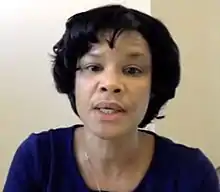LaShanda Korley
LaShanda Teresa James Korley is an Associate Professor of Materials Science at the University of Delaware. She was awarded the 2019 National Organization for the Professional Advancement of Black Chemists and Chemical Engineers Lloyd N. Ferguson Young Scientist Award for Excellence in Research.
LaShanda Teresa James Korley | |
|---|---|
 Korley discusses nanotechnology for the United States National Nanotechnology Initiative in 2016 | |
| Alma mater | Georgia Tech Clark Atlanta University Massachusetts Institute of Technology |
| Scientific career | |
| Institutions | University of Delaware Case Western Reserve University Massachusetts Institute of Technology |
| Thesis | PEO-containing Copolymers as Polyurethane Soft Segments in the Development of High Performance Materials (2005) |
| Doctoral advisor | Paula T. Hammond |
Early life and education
At the age of six Korley had realised that she wanted to teach.[1] She set her grandmother tests and taught classes on a toy blackboard.[1] Korley studied chemistry at Clark Atlanta University and graduated in 1998. She earned her bachelor's degree in chemical engineering at Georgia Tech in 1999. She has said she selected chemical engineering because she enjoyed physics, chemistry and mathematics.[2] Korley moved to the Massachusetts Institute of Technology for her doctoral studies, where she was a member of the Program in Polymer Science and Technology. She worked alongside Paula T. Hammond on the materials properties of polyurethanes.[3][4] After earning her doctorate in 2005 she joined Cornell University as a Provost's Academic Diversity Fellow.[5]
Research and career
Korley served a Climo Associate Professor in the Department of Macromolecular Science and Engineering at Case Western Reserve University from 2007. Her research involves nature-inspired design, so-called biomimicry, of mechanically enhanced tunable materials.[6][7] She has studied hygromorphic materials for controlled actuation, peptide hybrid materials and molecular gels.[7][8][9] At Case Western Reserve University her laboratory was called M-cubed (mechanically-enhanced, multi-functional materials).[2] She led the National Science Foundation Center for Layered Polymeric Systems. She was named a DuPont Young Professor in 2011.[10][11] That year she was selected for the National Academy of Engineering Frontiers of Engineering symposium.[12] In this capacity she collaborated with the Royal Academy of Engineering and Chinese Academy of Engineering.[13] In 2013 Korley became an Academic Careers in Engineering & Science (ACES) ADVANCE Opportunity Grant awardee.[14] She returned to Massachusetts Institute of Technology in 2015 as a Martin Luther King Visiting Scholar.[15] Here she worked on 3D printed structures that could be modified using light.[16] She also showed that it was possible to improve the mechanical properties of polymers by changing the rate at which different components were added to a blend.[17]
In 2018 Korley joined the University of Delaware as a Distinguished Associated Professor.[6][18] At the University of Delaware Korley is Principal Investigator for the National Science Foundation Partnerships for International Research and Education (PIRE).[19][20] She has investigated the molecular structure of the sea cucumber, caddisfly silk and the extracellular matrix in an effort to design materials for soft robotics, food packaging and scratch-resistant coatings.[7] She was awarded the 2019 National Organization for the Professional Advancement of Black Chemists and Chemical Engineers Lloyd N. Ferguson Young Scientist Award for Excellence in Research recognising her work on bio-inspired materials.[21]
Korley serves as Co-Director of the University of Delaware Future Faculty Workshop.[1][22][23]
References
- Stewart, Julie. "Developing Diverse Leaders". University of Delaware. Retrieved 2019-11-24.
- "LaShanda J. Korley PhD '05" (PDF). MIT. Retrieved 2019-11-24.
- Korley, LaShanda T. James; Pate, Brian D.; Thomas, Edwin L.; Hammond, Paula T. (2006-04-19). "Effect of the degree of soft and hard segment ordering on the morphology and mechanical behavior of semicrystalline segmented polyurethanes". Polymer. 47 (9): 3073–3082. doi:10.1016/j.polymer.2006.02.093. ISSN 0032-3861.
- Waletzko, Ryan S.; Korley, LaShanda T. James; Pate, Brian D.; Thomas, Edwin L.; Hammond, Paula T. (2009-03-24). "Role of Increased Crystallinity in Deformation-Induced Structure of Segmented Thermoplastic Polyurethane Elastomers with PEO and PEO−PPO−PEO Soft Segments and HDI Hard Segments". Macromolecules. 42 (6): 2041–2053. doi:10.1021/ma8022052. ISSN 0024-9297.
- "LaShanda Korley | Materials Science & Engineering". Retrieved 2019-11-24.
- "LaShanda Korley | Materials Science & Engineering". Retrieved 2019-11-24.
- "Spotlight on LaShanda Korley: 2017 Soft Matter Emerging Investigator – Soft Matter Blog". Retrieved 2019-11-24.
- Alexander, S. L. M.; Ahmadmehrabi, S.; Korley, L. T. J. (2017). "Programming shape and tailoring transport: advancing hygromorphic bilayers with aligned nanofibers". Soft Matter. 13 (33): 5589–5596. doi:10.1039/c7sm00962c. ISSN 1744-683X. PMID 28730198.
- Johnson, J. Casey; Korley, LaShanda T. J. (2012). "Enhanced mechanical pathways through nature's building blocks: amino acids". Soft Matter. 8 (45): 11431. doi:10.1039/c2sm26185e. ISSN 1744-683X.
- "Engineering faculty LaShanda Korley named DuPont Young Professor; earns $75,000 grant". The Daily. 2011-06-23. Retrieved 2019-11-24.
- "DuPont Young Professors Selected from Across the Globe Focus on New Science". Benzinga. Retrieved 2019-11-24.
- "Honor Roll – ASEE Women in Engineering Division (WIED)". Retrieved 2019-11-24.
- "Honor Roll – ASEE Women in Engineering Division (WIED)". Retrieved 2019-11-24.
- "13 faculty members earn ACES+ 2013 opportunity awards". The Daily. 2013-04-15. Retrieved 2019-11-24.
- "LaShanda Korley, Chemistry – Martin Luther King Jr. Scholars". Retrieved 2019-11-24.
- "MIT create adaptive 3D printing process using light". 3D Printing Industry. 2017-01-16. Retrieved 2019-11-24.
- "Simple technique produces stronger polymers". phys.org. Retrieved 2019-11-24.
- "Universitiy of Delaware | Department of Chemical & Biomolecular Engineering Magazine 2018". Issuu. Retrieved 2019-11-24.
- "PIRE Research Team". University of Delaware. Retrieved 2019-11-24.
- "NSF announces 14 new PIRE awards to support scientific collaboration in 24 countries". EurekAlert!. Retrieved 2019-11-24.
- "LaShanda Korley Recognized for Research". UD College of Engineering. 2019-11-22. Retrieved 2019-11-24.
- "UD Future Faculty Workshop". University of Delaware. Retrieved 2019-11-24.
- "Future Faculty Workshop | UDaily". www.udel.edu. Retrieved 2019-11-24.